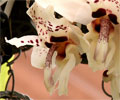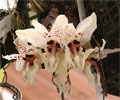|
|
|
|
|
| |
Flasks of
Stanhopea martiana 'Jenny 7/80 #2' × self |
|
| |
|
|
| |
| Number: |
TN6720 |
| Name: |
Stanhopea martiana 'Jenny 7/80 #2' × self
|
| Type: |
self (What's that?) |
|
Seed Donor: |
Troy C. Meyers
|
|
Click to Enlarge

Pod Parent Flowers |
Click to Enlarge

Pod Parent Inflorescences |
|
|
|
| |
Culture Notes from Donor: Parent plant: Temperature range I (60-83°F)
For additional origin/habitat information supplied courtesy of
Charles and Margaret Baker, see further below, near the bottom of this page.
|
Temperatures we attempt to use in the lab & greenhouse:
| For Species: |
|
Spring, Summer, Autumn: days average 79°F, nights 59°F; best fit is Cool-Intermediate 75-58°F
(Source:
Baker's Web OSC) |
| For Species: |
|
Winter: days average 73°F, nights 44°F; best fit is Cool 70-52°F
(Source:
Baker's Web OSC) |
|
About the name...
| Etymology of |
martiana |
|
Named for Doctor C. F. von Martius, a German orchid collector and botanist in Brazil, discovered numerous plants, including orchids, published "Flora Brasilensis," and was the director of the Botanic Garden in Munich during the 1st half of the 19th century.
(Source:
Mayr & Schmucker 1998) |
| Etymology of |
Stanhopea |
|
In honor of Philip Henry, 4th Earl of Stanhope, president of the London Medico-Botanical Society during the early part of the 19th century.
(Source:
Pridgeon 1992) |
| Pronunciation of |
martiana |
|
mart-ee-AH-na
(Source:
Hawkes 1978) |
| Pronunciation of |
Stanhopea |
|
stan-HOPE-ee-ah
(Source:
Pridgeon 1992) |
|
If you would like to direct someone to this web page, please copy and paste this URL into your email:
http://troymeyers.com/d?016720
| Flask Information |
| Availability: |
We have sold all of the flasks for this item. |
| You should: |
Consider getting individual plants or compots instead of a flask.
See if we have plants available in the greenhouse. |
| Yield Estimate: |
514 plants (based on flask surveys done 07/23/2009 through 11/12/2009)
|
| Plantlet Sizes: |
From many flasks 40 - 120 mm plants (based on flask surveys done 04/19/2010 through 07/13/2010)
From one most recently surveyed flask 40 - 100 mm (07/13/2010)
|
|
You might also want to:
|
View the seed assay for this item.
See if we have plants available in the greenhouse.
View items of the same species.
View items of the same genus.
|
| Ordering Information |
| You are not currently logged in. |
|
You must be a registered user and be logged in to reserve a flask or place a notification request. Please log in:
|
|
|
|
|
|
| |
The origin/habitat information below is supplied courtesy of Charles and Margaret Baker
The following information is based on the name of the plant provided by the donor, and assumes that the name is correct. If the plant has been misidentified, then the following information may not be correct.
This text is copyrighted by the Bakers and may not be reproduced without permission.
ORIGIN/HABITAT: Mexico. Known only from the Pacific slopes in the states
of Nayarit, Jalisco, Guerrero, and Oaxaca. Plants have been found near
Tepic, near the towns of San Sebastián, Autlán, Tecalitlán, as well as at
Talpa near Caule and near Los Pericos. Plants grow on rocks, usually at
4600-6550 ft. (1400-2000 m) in shaded deciduous forest, but sometimes in
oak or oak-pine forests. Kennedy (1975), however, reported that the plants
found around Tepic grow at only slightly more than 3300 ft. (1000 m).
More about this information and the Bakers...
|
|
|
| |
|
|
|